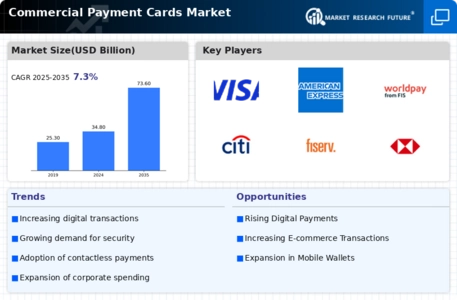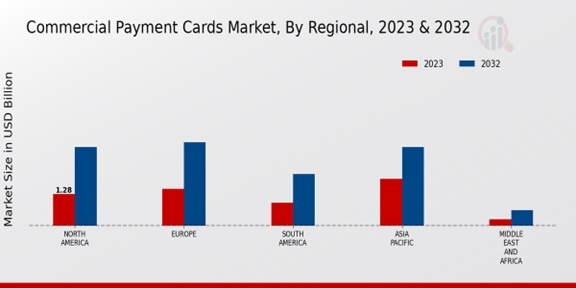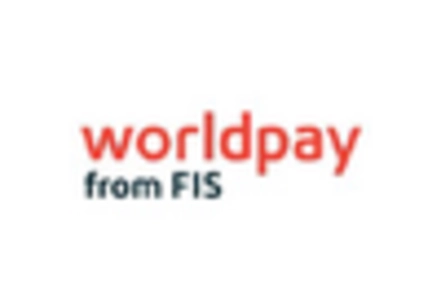Market Growth Projections
The Global Commercial Payment Cards Market Industry is poised for substantial growth, with projections indicating a market size of 34.8 USD Billion in 2024 and an anticipated increase to 73.6 USD Billion by 2035. This growth trajectory suggests a compound annual growth rate of 7.06% from 2025 to 2035. Such figures reflect the increasing reliance on commercial payment cards by businesses seeking efficient financial management solutions. The market's expansion is likely driven by various factors, including technological advancements, evolving consumer preferences, and regulatory support for digital payment systems.
Enhanced Security Features
Security remains a paramount concern in the Global Commercial Payment Cards Market Industry. The introduction of advanced security features, such as EMV chip technology and tokenization, significantly mitigates fraud risks associated with card transactions. Businesses are increasingly adopting commercial payment cards that offer these enhanced security measures, fostering trust among users. As organizations prioritize safeguarding their financial transactions, the demand for secure commercial payment solutions is likely to increase. This trend aligns with the projected compound annual growth rate of 7.06% for the period from 2025 to 2035, indicating a robust market response to security concerns.
Evolving Corporate Spending Patterns
The Global Commercial Payment Cards Market Industry is influenced by changing corporate spending patterns. Companies are increasingly focusing on optimizing their expenditure, leading to a higher utilization of commercial payment cards. This shift is indicative of a broader trend where organizations aim to enhance financial control and visibility. The ability to manage employee spending through commercial cards allows for better budgeting and expense tracking. As businesses adapt to these evolving patterns, the market is expected to grow, with projections indicating a rise to 73.6 USD Billion by 2035. This evolution in spending behavior underscores the importance of commercial payment cards in modern financial management.
Integration of Artificial Intelligence
The Global Commercial Payment Cards Market Industry is witnessing a growing integration of artificial intelligence (AI) technologies. AI enhances transaction processing, fraud detection, and customer service, making commercial payment cards more appealing to businesses. By leveraging AI, organizations can analyze spending patterns, identify anomalies, and streamline operations. This technological advancement not only improves efficiency but also contributes to cost savings. As AI continues to evolve, its impact on the commercial payment card sector is expected to be profound, potentially driving market growth as companies seek innovative solutions to optimize their financial processes.
Regulatory Support for Electronic Payments
The Global Commercial Payment Cards Market Industry benefits from increasing regulatory support for electronic payment systems. Governments worldwide are implementing policies that promote digital transactions, aiming to enhance financial inclusion and streamline economic activities. Such regulatory frameworks encourage businesses to adopt commercial payment cards as a preferred method of payment. This supportive environment is likely to stimulate market growth, as organizations align with government initiatives to transition towards cashless economies. The synergy between regulatory support and market demand could further propel the commercial payment card sector, fostering innovation and competition.
Increasing Adoption of Digital Payment Solutions
The Global Commercial Payment Cards Market Industry experiences a notable shift towards digital payment solutions. Businesses increasingly prefer electronic transactions due to their efficiency and security. This trend is evidenced by the projected market size of 34.8 USD Billion in 2024, reflecting a growing reliance on commercial payment cards. The convenience of managing expenses and tracking transactions digitally is appealing to organizations. Furthermore, the integration of advanced technologies such as mobile wallets and contactless payments enhances user experience, potentially driving further adoption. As businesses seek to streamline operations, the demand for commercial payment cards is likely to rise.




















